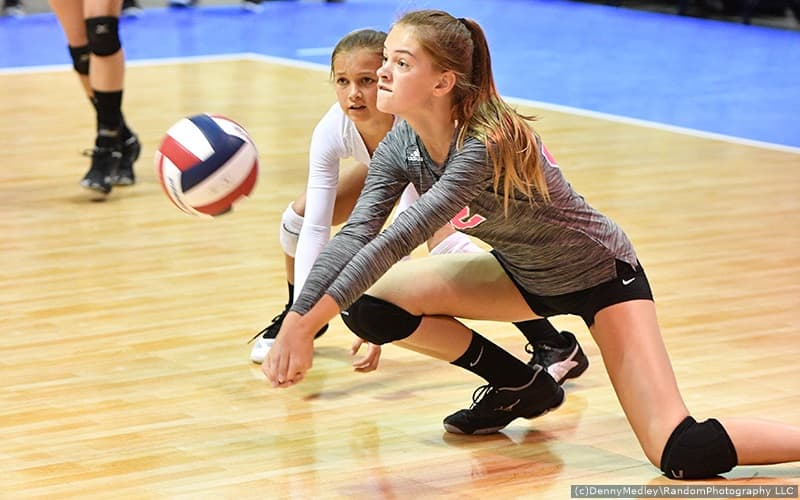
I am often reminded of the importance of winning the serve/serve reception war.
For decades I have been concerned about how far too many coaches focus on the technique of passing, practicing for practice’s sake and not performance. The desire for practice to look good means that teams waste a great deal of time passing on the same side of the net and fail to train enough in how matches actually proceed.
Let’s start with some facts. Every single point starts a serve. That ball goes over the net, and the receiving team must read the server and the ball flight before they can receive it. How many of your drills start with a serve? I contend it is not enough. U.S. Men’s National Team head coach John Speraw says, “Working on serve/serve receive 100% of the time is not enough;” CAP Cadre member Rob Browning agrees. “You think you have serve and serve received enough, but you never have.”
National and international players report that at least 80 percent of their success in serve receive comes before the ball crosses the net. That is a great example of how important reading the ball is during a match. Unfortunately, most teams spend far too much time on pair pass and/or wall pass. How much of this 80-plus percent average have your players acquired when peppering or passing against a wall? None, nada, zero. It is practicing for practice, not performance.
If you ask most setters where their teammates will likely send the serve reception, they will point in front of the receiver or over the net in front of the receiver. These poor setters stand in the target zone at the net, but generally they must move when serve receivers spend most of their time passing back to where it came from. Doing pairs with the first contact going right back over the net is merely a disguised pair-passing drill that puts the ball straight back where it came from. I simply don’t want my players to know how to do that.
How important is this over-the-net reality compared to, for example, serving machines? Well, the Toronto Blue Jays get it. They hired former pitchers to actually pitch during batting practice. This gives plenty of additional practice reading the incoming ball. While we’re on the topic, have you ever seen tennis pros practice on the same side of the net? Even their warm-up before a grand slam final is done over the net.
This should also apply to volleyball and the time wastes of pepper and digging coaches from a box. This is about giving your players reps with the most important contact in every single point they will play: the serve/serve reception. Please remember three of the most important aspects in reception:
- Who’s ball? – Encourage communication about who receives the serve. This can be non-verbal.
- Play it or let it go? - Countless out balls are incorrectly played at all levels.
- How to angle it? – Aim for the setter, and produce a flight path that gives the setter time and space to set it.
None of these key components in the true skill of serve reception are learned in pair or wall passing.
After more than 25 years in the Paralympic sports world, I have learned that technique is individualistic. Rather than you dictating position and technique, help your players discover their best way to play the game, guided by biomechanical principles. Too many coaches want technique to be the main focus and drill players as if they are machines. Humans are not machines, though. There’s a natural variance to our actions, and not just from person to person, either.
It is not about doing technical training until you learn to play, rather you learn techniques through playing. One of the best golf coaches ever, Harvey Penick, would give a brand new golfer a set of club and tell them to go hit the ball and come back in six months. His book on golf, The Little Red Book, is a must read for all coaches. This article shares examples of his life lessons from golf, another rebound sport. Once a volleyball player displays the core technique without a ball, they understand it. Now they need many thousands of game-like repetitions to develop a sense of ideal positioning. When it is not possible to be in the absolute best position to receive a serve, they must develop full-body solutions to keep the ball off the floor.
The principle of serve reception is simple: reflect the incoming serve off your body to the target. When I was coaching kids in Italy, I asked them to deflect high serves off the back of their forearms (this was before you could overhead pass a serve). They proceeded to prove my technical flaw by taking every high ball on a serve with their forehead and passing it right to the setter. Simple is better than complex, and if you want to see more about how to volley the ball technically without using your arms, just watch any of the hundreds of clips of FootVolley and Sepak Takraw.
We tend to get stuck in teaching the ways we were taught, but is the whole body legal in volleyball? How long has it been legal in beach? Indoor play? How much time during practice do you let your players learn and discover how to use anything other than their arms to rebound the ball? I look forward to your thoughts about being great at serve reception and not passing